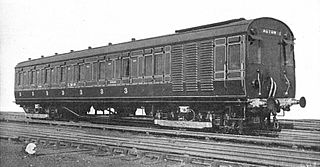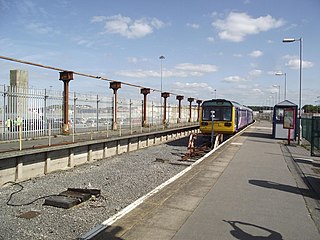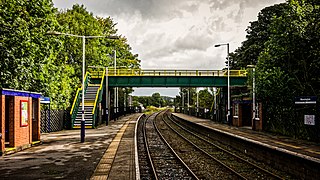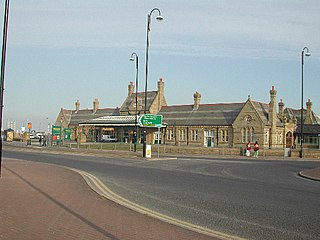
The London, Midland and Scottish Railway (LMS) was a British railway company. It was formed on 1 January 1923 under the Railways Act of 1921, which required the grouping of over 120 separate railways into four. The companies merged into the LMS included the London and North Western Railway, Midland Railway, the Lancashire and Yorkshire Railway, several Scottish railway companies, and numerous other, smaller ventures.

Heysham is a coastal town in Lancashire, England, overlooking Morecambe Bay. It is a ferry port, with services to the Isle of Man and Ireland, and the site of two nuclear power stations.

The London, Midland and Scottish Railway (LMS) was involved in the development of railway electrification of Britain. Like the LNER and the SR the LMS took over several schemes that had been developed by its constituent companies and also completed some of its own. All were suburban lines, in London, Liverpool and Manchester, and were usually steam lines converted to electric traction. Each service is listed below, showing dates of opening and the railway responsible for its conversion.
The Midland Railway experimented with electrification on its Heysham–Morecambe–Lancaster line in Lancashire, England. Electric trains started to run over this route in 1908, using the overhead 6.6 kV, 25 Hz AC electric supply installed and generated at the MR's own power station in Heysham.
The North Western Railway (NWR) was an early British railway company in the north-west of England. It was commonly known as the "Little" North Western Railway, to distinguish it from the larger London and North Western Railway (LNWR).
The Morecambe branch line is a railway line in Lancashire, England, from Lancaster to Morecambe and Heysham, where trains connect with ferries to Douglas, Isle of Man. To reach Heysham, trains must reverse at Morecambe.

Lancaster railway station is a railway station that serves the city of Lancaster in Lancashire, England. It is one of the principal stations on the West Coast Main Line. It is located 20 miles 78 chains (33.76 km) from Preston and is the zero point for mileages onward to Carlisle.

Heysham Port is a railway station on the Morecambe Branch Line, which runs between Lancaster and Heysham Port. The station, situated 7+3⁄4 miles (12 km) west of Lancaster, serves Heysham Port in Lancashire. It is owned by Network Rail and managed by Northern Trains.

Morecambe is a railway station on the Morecambe Branch Line, which runs between Lancaster and Heysham Port. The station, situated 4 miles (6 km) west of Lancaster, serves the town of Morecambe in Lancashire. It is owned by Network Rail and managed by Northern Trains.
Events from the year 1933 in art.

Hellifield is a railway station on the Bentham Line, which runs between Leeds and Morecambe via Skipton. The station, situated 36 miles 17 chains (58.3 km) north-west of Leeds, serves the village of Hellifield, Craven in North Yorkshire, England. It is owned by Network Rail and managed by Northern Trains.

Wennington is a railway station on the Bentham Line, which runs between Leeds and Morecambe via Skipton. The station, situated 15+3⁄4 miles (25 km) east of Lancaster, serves the village of Wennington in Lancashire. It is owned by Network Rail and managed by Northern Trains.

Morecambe is a seaside town in the City of Lancaster district in Lancashire, England, on the southern coast of Morecambe Bay.

Morecambe Promenade Station was a railway station in Morecambe, Lancashire, England. It was opened on 24 March 1907 by the Midland Railway and closed in February 1994. After twelve weeks break in passenger service for the revision of track work and signalling a new Morecambe station was opened on a site closer to the town centre.

The Leeds–Morecambe line, also known as the Bentham line, is a railway line running between Leeds, Skipton, Lancaster and Morecambe in northern England. The service is operated by Northern. The route covered by the service was historically part of the Midland Railway. The line is electrified at 25 kV AC overhead between Leeds City and Skipton- this section is known as the Airedale line.

Eric Gill works at the Midland Hotel, Morecambe include a sculpture, reliefs and a medallion.

Morecambe Euston Road was the terminus station of the London and North Western Railway's branch line to Morecambe, in Lancashire, England. It closed in 1962, after which all trains to Morecambe used the nearby Morecambe Promenade station.
The North Western Hotel in Morecambe, Lancashire, England, was built in 1847–48. It was designed by the Lancaster architects Paley and Austin for the "Little" North Western Railway. Including furnishings, it cost £4,795. It was a two-storey building containing 40 bedrooms. In 1871, when the railway became part of the Midland Railway, its name was changed to the Midland Hotel. It was demolished and replaced by a new hotel, also called the Midland Hotel, in 1932.

The Park Hotel was a railway-owned hotel at East Cliff, Preston, Lancashire, England, used for many years as offices, but now being restored as a hotel.
Morecambe Northumberland Street railway station served the seaside town of Morecambe in Lancashire, England.



















